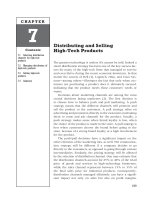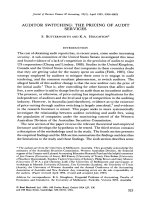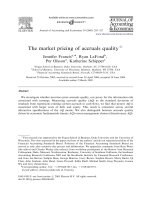Pricing High-Tech Products
Bạn đang xem bản rút gọn của tài liệu. Xem và tải ngay bản đầy đủ của tài liệu tại đây (185.68 KB, 24 trang )
Pricing High-Tech Products
Successful marketing companies know that pricing comes last
when formulating the marketing mix of a product. The reason
is very apparent: The price has to cover all the costs, including
the product development and management costs, the distribu
-
tion costs, and the communication costs in order to make a
profit. Sometimes, a company may decide to price under cost
for a given product on a given market for a given amount of
time, but this is an exception, which cannot last forever.
Indeed, the impact of price is felt not only in sales volume
and market share, but also financially as price determines a
company’s profitability. Indeed, according to the cost structure
of a firm, a 1% price increase can improve profit margin by
more than 50% [1]. For some companies in the computer busi-
ness, for instance, where margins are very low, smart pricing is
essential to survive [2]. Once you set the price for a product, it
is extremely hard to change it [3], because customers never
appreciate significant price fluctuations, as many “dot-com”
firms have learned the hard way before collapsing. Once a price
is made for a product, it is almost futile to increase it; on the
other hand, a sudden price decrease may also have a negative
impact on the product’s perceived value leading to diminishing
market share, volume, and profitability.
Price is also an important part of the marketing strategy,
because a price strengthens a product’s positioning in a market
segment; that is, high-quality products usually call for high
prices. Additionally, price is a basic element in the exchange
between a company and its customers, even if it is not the only
decision factor in the purchase of a high-tech product. On that
matter, one has to consider that the prices of high-technology
products are much higher than average prices of standard
products: The price per kilogram of a satellite is 20,000 times
higher than a kilogram of building material and 2,000 times
higher than a kilogram of an automobile (see Figure 9.1).
239
9
Contents
9.1 Determining price limits
9.2 Setting the price of
high-tech products
9.3 Adapting a price policy
to different types of high-tech
products
9.4 Integrating the other
determinants of price
9.5 Managing price
9.6 Summary
CHAPTER
Consequently, price decisions are rarely made by just the marketing
department [5] but at the top level of the company, at least for all the major
products and innovations. According to a study performed in French high-
tech firms, the final price decision in 50% of the cases is made by the chief
executives, in 40% of the cases by a sales manager, in 30% of the cases by a
multifunctional committee, and only in 20% of the cases by a marketing
director [6].
In a world where products and competitive positions change very
quickly, price managers must know how to adapt continuously the listed
price of the product [7]. The price makers must first determine the pricing
mix among the various pricing models; then they must figure out the vari
-
ous price limits in order to get the general framework of the pricing policy.
Next they must select the most relevant pricing method according to the
type of products they want to market, as well as other drivers such as the
existing range of products and the anticipated reactions of the various play
-
ers in the market. Finally, they have to manage the price dynamically.
The first step of the pricing strategy starts with the analysis of the various
sources of revenues that a product can potentially generate. For instance, a
computer or a satellite can be sold directly, but they can also be leased or
charged on a per use basis, like IBM’s new business model of “computer on
demand.”
In the case of some product such as software or some technologies, the
customer doesn’t buy the source product but pays for a license to use it. This
240 Pricing High-Tech Products
$1/kg
$4/kg
$10/kg
$100/kg
$1,200/kg
$20,000/kg
Construction
Packaging Automotive
Consumer
electronics
Aviation
Satellites
Figure 9.1 Price comparisons of high-tech and standard products. (From: [4].
©1991 French Ministry of Industry. Reprinted with permission.)
license can be charged by user, but also by site, and also by number and
even by type of computer running the software. Its duration time may also
vary. For instance, in 2002 Cadence, a leading firm marketing software for
semiconductor design companies, introduced a “3-year” licensing scheme
instead of the usual “99-year.” Similarly, AutoDesk, a CAD software vendor,
switched from a permanent license to a yearly subscription. Such a price
policy change seeks to stimulate more repeated upgrades while diminishing
the purchase price paid by the customers, though it has to be done repeat
-
edly over the life time use of the software [8].
In the case of high-tech services such as the i-mode service offered by
Japanese telecommunication operator NTT DoCoMo, for example, money
can flow directly or from commissions. Direct revenues come from monthly
subscriptions plus from the amount of e-mail and data downloaded from
the 35 millions users; portal advertising and portal usage fees produce reve
-
nues, as well. Revenues also come indirectly from commissions on the
m-commerce services available, as well as a commission (9% in 2003) on
service revenues to content providers using the DoCoMo such as the hugely
popular on-line games or sports information services. In 2003, DoCoMo’s
revenue mix was 13% from subscriptions, 10% from e-mail, 63% from
Web access, and 13% from third-party content. The pricing strategy must
balance the various pricing solutions for each of the sources of the revenue
mix before setting the price for each of the components.
Price may be fixed but can also be variable in order to get a better bal-
ance between demand and supply, as is illustrated in Table 9.1. Variable, or
dynamic, pricing has always been used for overstocks or commodity sup-
plies. However, today, thanks to the Internet, it can also be more easily
applied to high-tech consumer goods, such as electronics, as well as all
categories of business goods through auctions or reverse auctions (see
Section 9.2.4). Indeed, on the Internet prices can be changed on an hourly
or daily basis at a very low cost compared to the weekly or monthly changes
in the traditional brick-and-mortar channels. Furthermore, it is easier to
analyze the nature of the sales, the consumer preferences and attitudes, or
the demographic data of the visitors on a Web site. Finally, an increasing
Pricing High-Tech Products 241
Table 9.1 The Various Pricing Models
Pricing
Mode Nature of Revenues
Fixed Variable
One-off sale Per use
Direct Permanent license Time-based license
Leasing Subscription
Indirect Advertising (cost
per thousand)
Advertising per click
Commission
Collection charge
number of price-sensitive customers are using price-comparison Web sites
before purchasing on the Net, pushing for more competition on price [9].
The combination of those different factors is pushing companies to set a
dynamic pricing policy, which takes into account and adapts in real time to
any variation of the supply or demand in the market.
Another key element to consider is the nature of the product to be
priced. Indeed, the product can be innovative; it can also be evolutionary
and market driven, as an upgrade or an improvement of an existing prod
-
uct; it can also be just a copycat of another product already in the market
(also known as a “me-too” product). To begin with, one has to do an honest
assessment of the product’s status. Some high-tech firms tends to consider a
product as revolutionary (for them, but not for the market) when it is just
market-driven and even sometimes a rough imitation, because the company
is late getting it to the market.
The pricing decision is significantly affected by the status of the product.
For instance, a frequent error made by many high-tech companies is to
underprice revolutionary products in order quickly to build market share
and because it is difficult to evaluate their value for customers. Similarly,
underpricing an upgrade product, which actually offers substantial added
value, can ignite cannibalization or a price war. On the other side, overpric-
ing a me-too product, which falsely differentiates from the competition, will
translate into market failure.
9.1 Determining price limits
The price of a product always fluctuates between two points: the price ceil-
ing and the bottom price (see Figure 9.2). The market segment being
addressed determine the price ceiling; no customer will buy above this level,
and this price ceiling will be translated into a zero market share. For
instance, Vertu, a Nokia subsidiary, has priced at 24,000 Euros (more than
$21,000) limited editions of a platinum handmade cell phone handset.
Other cheaper gold models go for approximately 6,000 Euros apiece.
The bottom price is established by the cost structure of a product; below
this price the company loses money on every product sold, which leads to a
negative return as detailed in Section 9.2.7. With the specifications of high-
tech products, a marketing manager must evaluate these two limits by ana
-
lyzing the price elasticity of demand of the targeted market segments and by
estimating the costs’ learning curve.
9.1.1 Evaluating the price elasticity of demand
The price elasticity of demand in relation to price measures the variation of
customer purchases according to an increase or decrease in price: If elasticity
is high, demand for a product is influenced by its price. Understanding
demand elasticity for a product allows firms to determine which products
drive market penetration and thus require a low penetration price, and
242 Pricing High-Tech Products
which solutions can be priced at a premium, like in the case of video cell
phones or broadband subscription.
Usually, innovative high-tech products have low elasticity. This means
that high variation in price, an increase as well as a decrease, does not sig-
nificantly modify demand. These high-tech products have few substitutes,
meaning that the costs to switch to another product are high. Additionally,
at the first stage of the technology, buyers—either innovators or forerun-
ners—are less sensitive to price than to additional performance; they often
have deep pockets or are ready to spend a lot for a new innovative and out
-
standing product. For instance, with its new product range, Vertu is aiming
at the 3% of millionaire households with assets of more than $2.5 million;
those are customers who are ready to accept the price range mentioned
above. At that stage, the competitors are not interested in lowering their
price significantly whatsoever, because they are chasing the same categories
of customers, not sensitive to price. Furthermore, the high price of these
products is often perceived as a sign of quality and reinforces a customer’s
confidence in the company.
AOL successfully used the low elasticity for its product on the U.S. mar
-
ket. It started with a penetration pricing strategy at low price to establish the
product in the market. Then AOL managed to raise the price without losing
too many customers, because there were no direct competitors at that time
and because the switching costs for the customers were high.
The price elasticity of demand increases for market-driven or less inno
-
vative high-tech products. The entry of competitors with similar but less
expensive products or new products with a better price-performance ratio
makes the buyer more sensitive to price. Ultimately, the product becomes
standardized and its high price loses a part of its reassuring value. In this
9.1 Determining price limits 243
Actions
Pricing techniques
Product cost
structure
Market segment
acceptance
Price pointers
Evaluation of demand
elasticity to price
Competitors’ price
checks
Competitors’
pricing strategy
Measure of the
learning curve
Comparison
with substitute
products
Pricing to value
Market price
Bidding price
Break-even point
Cost + profit margin
Bottom price
Ceiling price
Figure 9.2 From bottom price to ceiling price.
case, a significant decrease in price would lead to a large increase in demand
as can be seen now in the home electronics and personal computer markets.
Such a pricing strategy is sometimes known as penetration pricing.
A foolproof method does not exist for determining the elasticity of a
product. In the case of high-tech products, the task becomes even more dif
-
ficult because of the short product life and fast rate at which these products
change. In addition, it is impossible to use statistics of past demand usually
because these numbers do not exist. Finally, test markets are very costly and
quickly outdated, so a high-tech company often must rely on surveys of cus
-
tomers who used the prototypes or tested the new products in the hope that
these customers are representative of the overall segment. This is not always
the case, as experience shows that innovators and early adopters are less
price-sensitive than other consumer categories. Often a company must take
chances and perform an analysis to predict the buying behavior of target
customers, while referring to available data for products that the new prod
-
uct will replace.
Eventually, a high-tech product’s elasticity can usually be measured by
noticing shifts in price through sales figures. For instance, when the major
U.S. chemical company DuPont, soon after introducing a new fiber called
Kevlar, had to revise its price upward, customers protested but in the end
accepted the increase. In another case, when a large French chemical com-
pany increased prices of all its molecules (mostly elastomers) by more than
30%, it managed to keep almost all its customers; only one segment
changed suppliers.
Similarly, in the mainframe computer industry, whose customers are big
private firms or governmental agencies, the recent trend of decrease in price
has led to a volume extension. A new CMOS technology and the increasing
use of standard components have allowed vendors like IBM, Amdahl, and
Hitachi to decrease their prices since 1992. On average, a 25% decrease in
unit price has translated into an increase of 10% in volume.
9.1.2 Estimating the costs’ learning curve
Successful high-tech firms are constantly monitoring costs in order to keep
these costs down. To show a profit that encourages future investments, a
company must at least cover its variable costs that are linked to production
volume and its fixed costs (salaries, rent, administration, R&D) that are nec
-
essary to manufacture its product. Identifying and controlling these costs
can lead a company to measure its learning curve.
This learning curve effect corresponds to the company’s improved
know-how as its production increases during the growth stage of the life
cycle: purchasing optimization, design simplification for manufacturing pur
-
poses, output increase for production facilities, improvement of sales force,
selection of distributors, and increased performance of sales promotion cam
-
paigns. All these gains in productivity lead to a decrease in the average unit
cost. This decrease in cost could be passed on to the price in order to react to
a competitor’s actions or to increase price-sensitive demand.
244 Pricing High-Tech Products
This strategy is characteristic of the electronics industry. Intel, Samsung,
Infineon, and the other players use this strategy for pricing their memories
and semiconductors. Sometimes they engage in price wars, like in 2001
when the market price of PC memory (DRAM) fell below the cost of pro
-
duction, forcing weaker players, such as Hynix, out of the industry (see also
Section 9.1.3).
Microcomputer manufacturers have also chosen this strategy. In the cell
phone business, Nokia has aggressively pursued a manufacturing cost con
-
trol strategy to drive the price of mobile phones down in order to enlarge
the market and reach “mainstream” and late majority customers, as well as
to chase competitors with smaller volumes out of the game.
On the other side, the company can decide to pocket the productivity
gains and increase its margin and profitability. This is the successful
approach followed by Logitech, the PC accessories leading vendor. Logitech
produces about 100 million units per year and because its products have a
longer shelf life than with PCs, Logitech can drive manufacturing costs
down. In the meantime, the retail price for its products tends to stay con
-
stant, allowing the company to keep the same price for a product such as a
cordless optical mouse at the same level 18 months after its introduction.
The difference between a fixed retail price and a diminishing cost of manu-
facturing goes directly to the bottom line.
The learning curve is valid for high-tech products because of the high
level of R&D costs required by these products. Because the product life
cycles are fairly short, these expenses must be written off very quickly (for
example, in 1 year for computers, and in 2 years for robotics) and these R&D
costs inflate the average unit cost at the beginning of the product’s life,
before decreasing very quickly. This unit cost variation is reflected in the
changing unit price.
Figure 9.3 illustrates the cost experience curve for magnetic disk storage
over 10 years. In recent years, the cost of a gigabyte of storage has fallen
dramatically, from $165 in 1995 to $1.4 in 2003 and a projection of $0.2 in
2006. Today storage has become a mass product and the quantity of storage
capacity is enormous. For instance, in 2003, Aetna, the U.S. leader of health
and related benefits, had more than 174 terabytes (1,000 gigabytes) of data
based on more than 4,100 direct-access storage devices and representing
about 250,000 tape volumes; Boeing had about 150 terabytes of data over
150,000 desktops; in Europe, ATOS-Origin a high-tech service firm man
-
aged about 300,000 terabytes attached to 60 mainframes and more than
5,000 mid-range servers.
Every marketing manager must continuously follow the changes in the
average unit cost and its position on the price experience curve according to
the trend of the market price. A company that notices its costs decreasing
much faster than market prices knows that it is benefiting from its experi
-
ence and is gaining by profit margin and market share.
On the contrary, a company with costs that are increasing faster than the
industry average will see its margins fade away. This company is losing its
maneuvering autonomy as well as its market share. Usually, at this point,
9.1 Determining price limits 245
the company will complain of “dumping,” “unfair competition,” or “compa-
nies that are undercutting prices,” without realizing that its inability to be
more successful (attaining a higher performance level) is leading to its own
failure.
Marketers must also avoid another hazard, which is to overstate the
manufacturing potential when establishing the price. Indeed, if an aggres-
sive pricing stirs market demand above production capacity, it directly
impacts customer satisfaction (and brand image) because of excessive
delays. Furthermore, it affects profitability, because firstly the company
is not getting the full infusion of revenues at launch time, and secondly,
available products could have been sold at higher prices. Apple went
through this tough experience in 2003 when it started to ship its 17-inch
PowerBook several weeks after the official availability date of February
2003. The previous year, it had had similar problems with the 15-inch flat
panel iMac, which was introduced at Macworld Expo in January 2002, but
was really available 3 months later in April 2002, leaving the company with
a significant backlog of orders for the iMac at the end of its first financial
quarter.
Such trouble does not occur for companies that have implemented a
“built-to-order” manufacturing model, or a variable pricing scheme, which
allows for quick rebalancing between demand and supply through price
adjustment. Actually we should note that the learning curve analysis is
adapted to products that can be mass produced, rather than to very custom
-
ized manufacturing systems, even if R&D costs need to be written off in both
situations.
246 Pricing High-Tech Products
0
20
40
60
80
100
120
140
160
180
1995 1996 1997 1998 1999 2000 2001 2002 2003 2004 2005 2006
Projected
CAGR1995–2003: (55%)
Storage price
($/gigabyte)
Figure 9.3 Cost experience curve for magnetic disk storage. (Source: IBM
Research, IDC, analysis by Eric Viardot.)
9.1.3 Taking competitors into account
In the high-tech world more than in any other industry, the first company
on the market sets the market price, particularly for a very innovative prod
-
uct. For a company that does not take the pole position, competitors will set
the standards [10] and this company must position itself according to them.
Some very successful companies take advantage of being first on the
market to get the maximum price possible and to skim the top off the mar
-
ket, a pricing strategy known as “skimming.” Yun Jong Yong, CEO of
Samsung Electronics, calls it the “sashimi theory.” When prime fish is first
caught, it is very expensive at a top-notch Japanese restaurant. If some of
the fish is left over, it sells the next day for half the price at a second-tier res
-
taurant. By the third day, it goes for one-fourth the price. Then it’s dried
fish. Samsung has successfully applied this theory in consumer electronics.
It markets the most sophisticated products ahead of the competition and
charges premium prices before the product is no longer fresh and competi
-
tion is there.
However, smart pricing offers opportunities for new or late entrants to
take over existing vendors. For example, in the phone business, new
entrants are pricing their solutions to maximize the number of users switch-
ing from the incumbent. In Europe, like in the United States, most new
entrants have started out offering a 15% to 20% discount, as did Vodafone
and Bouygues Telecom in France, or Sprint and MCI in the American mar-
ket. Experience shows that those discounts decrease to almost nothing over
time once the average market price reaches a level where the relative mar-
ket shares of the major players are stabilized.
Price contributes to the competitive positioning of a product on a given
market segment and may be a competitive weapon by changing customers’
perceptions of the competitors’ products. Accordingly when facing a par
-
ticular competitor, a company can set a higher price if its customers feel that
its product provides a higher level of performance and if they have a better
image of the product. Such is, for instance, the new pricing policy success
-
fully initiated at Apple Computer by its new ex-CEO Steve Jobs. The high
relative price of Apple’s products compared to similar products in the same
category reflects a positioning of quality and innovation. On that matter
Apple’s pricing strategy follows the successful track of BMW in the auto
industry.
On the other hand, a company can start aggressively to decrease its
prices if it has a lower cost structure or if it enjoys more flexibility with its
distribution channels than its competitors. Dell in the PC industry and Linux
in the software business are two good examples of organizations that have
managed to boost market share, and margins, with a penetration pricing
strategy. Their main rivals have a higher cost structure and cannot match
their low costs.
However, companies have to be careful before deciding to enter into a
price war. To unsophisticated marketers, the rationale for such a decision is
clear-cut: Lower the prices and the sales will soar. Reality is far more
9.1 Determining price limits 247









